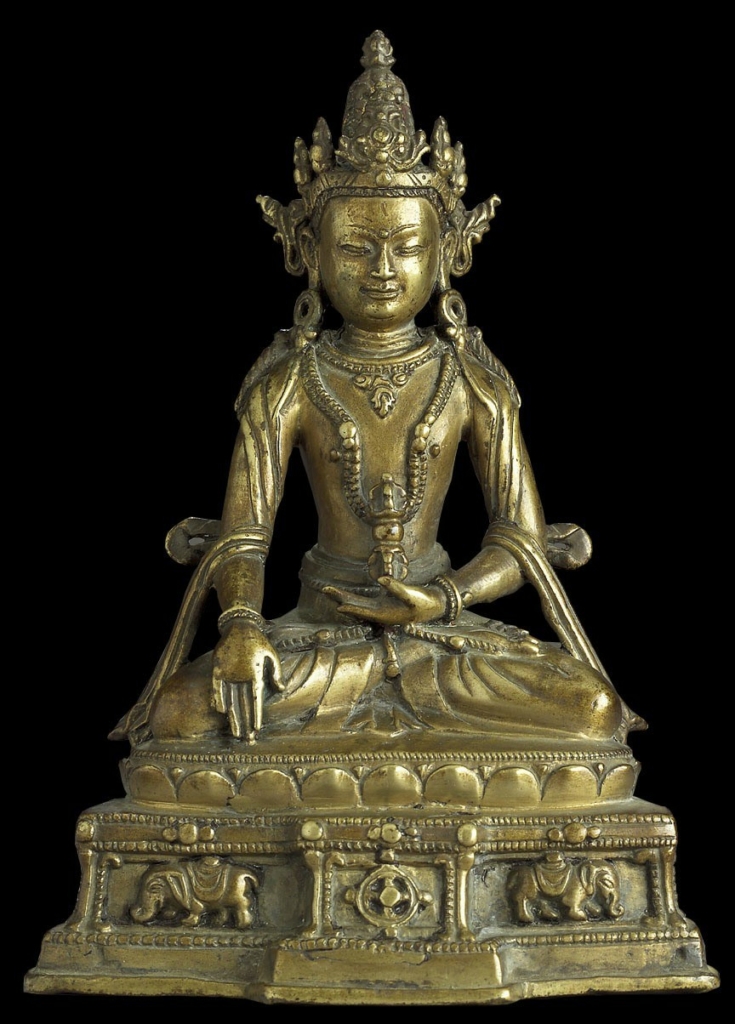Akshobhya and Shakyamuni Buddha Comparisons
Shakyamuni Buddha and Akshobhya Buddha are both important figures in Buddhism. Both are considered to be enlightened Buddhas who have achieved enlightenment and are revered as teachers of the Dharma.
The main similarity between Shakyamuni Buddha and Akshobhya Buddha is that they both represent the same core teachings of Buddhism. They both emphasize the importance of meditation, mindfulness, and compassion in achieving enlightenment.
Upon initial inspection, Shakyamuni Buddha and Akshobhya Buddha may appear to be alike; however, it is important to pay attention to the minute details of their figures, such as their hand gestures and any items they may be holding or wearing, in order to tell them apart. Let us take a closer look at the various symbols that are associated with each of these Buddhas, as these can help us to distinguish between them.
Shakyamuni Buddha is the historical founder of Buddhism, while Akshobhya Buddha is a celestial buddha associated with the Vajrayana school of Buddhism. Shakyamuni Buddha is represented as a human being, while Akshobhya Buddha is represented as a celestial being.
Table of Contents
Budddha Akshobhya
Akshobhya, the Buddha (Tibetan: mi kyu pa, sang gye), is a major figure in Vajrayana Buddhism and is associated with the eastern side of a mandala. He is also a minor buddha in the Mahayana sutras and resides in the Abhirati buddhafield.
Akshobhya, meaning “unshakeable”, is a prominent figure in Mahayana and Vajrayana Buddhism. He is described in the Mahayana Sutras of Northern Buddhism and in Tantric literature.
Although he is not as important in the Sutras, Akshobhya is a major figure in the Tantras and plays a significant role in Vajrayana Buddhism.
He can be easily identified in paintings by his blue body color, left hand supporting an upright vajra scepter, and buddha-like form. Additionally, he is often depicted with jewel ornaments and a crown, unlike any other Buddhist figures.
Akshobhya Buddha with a Vajra

Akshobhya Buddha with ornament

Shakyamuni Buddha
Siddhartha Gautam, born in the 5th century BCE to a royal family in Lumbini, was given the title of Shakyamuni Buddha after achieving enlightenment. This name is derived from the sage of Shakyas, his clan, and ‘Buddha’ means ‘the awakened one’ or ‘the wise one’, which is related to ‘Buddhi’, the term used to describe someone who has reached Nirvana.
Before becoming the Shakyamuni Buddha, Siddhartha lived a life of comfort and privilege, yet was deeply disturbed by the suffering he observed in the world. He chose to leave his royal status behind and embark on a spiritual journey to uncover the truth and find a way to end human suffering.
After years of practice and meditation, he finally achieved enlightenment under the Bodhi tree in Bodh Gaya, India. Following this, he started to spread his teachings about the nature of reality, the causes of suffering, and the path to liberation, which eventually led to the establishment of Buddhism as a religion.
Iconographic similarities between Buddha Akshobhya and Buddha Shakyamuni
The two figures of Shakyamuni Buddha and Akshobhya Buddha are both highly regarded in Buddhism, and have many similar teachings, characteristics, and representations. Here we will look at the iconographic similarities between the two.
Bhumisparsha Mudra
The Bhumisparsha Mudra, also known as the Earth-Touching Mudra, is a gesture that is commonly seen in depictions of Shakyamuni Buddha and Akshobhya Buddha. In this mudra, the right hand is extended across the knee with the fingertips bent down to touch the earth. This mudra symbolizes the moment when the Buddha attained enlightenment and is meant to invoke the earth goddess and stand for the triumph against evil. It is believed to inspire spiritual aspiration and determination.
Poses and Posture
The postures, mudras, and poses depicted in Buddhist art and sculptures are not only physical representations of deities, but they also serve to communicate and spread philosophical and metaphysical ideas.
The most common postures include the seated, standing, reclining, and walking Buddha. Shakyamuni Buddha and Akhsobhya Buddha are often shown in the same seated position, with crossed legs and each foot placed on the opposite thigh, typically on a moon disc symbolizing bodhicitta or compassion. This posture is called padmasana and is associated with meditation and contemplation.
Physical Attributes
A characteristic of the meditative posture, both the Buddhas are depicted with serene facial expressions and half-closed eyes, which can be fully closed in some depictions. They are also similarly displayed with elongated earlobes that help us identify Buddha. Physical attributes like the unisha and robes they drape are also similar but can vary in ornamentation and other details.
Iconographic differences between Buddha Akshobhya and Buddha Shakyamuni
Given the iconographic similarities between the two Buddhas, it is no wonder that many people confuse the figures of the two Buddhas. However, significant differences can help us correctly identify Shakyamuni Buddha from Aksobhya Buddha and vice versa
Position of Vajra
The positioning of the vajra is an important factor to consider when attempting to distinguish between the Buddhas. Vajras, a five-pronged ritual item, is a symbol of the Vajrayana schools of Buddhism and is representative of the power to cut through ignorance. Shakyamuni Buddha usually has a vajra placed in front of him on a lotus seat, while Akshobhya Buddha holds the vajra in the palm of his left hand with it standing upright, signifying the importance of the Vajra family in Tantric Buddhism.
Ornaments
Aksobhya Buddha is often depicted wearing jewels and a lavish crown, which is not typically seen in depictions of Shakyamuni Buddha. While it is possible to find images of Shakyamuni with such adornments, it is not a common characteristic of his, whereas Aksobhya Buddha is usually portrayed with these luxurious decorations.
This article aims to provide insight into the distinguishing features between Shakyamuni Buddha and Aksobhya Buddha. By considering the points mentioned, one should be able to identify the depictions of these enlightened beings. We hope this article has been helpful in teaching you the differences and similarities between the two Buddhas.









